2007 INFINITI QX56 heating
[x] Cancel search: heatingPage 996 of 3061

OVERHEATING CAUSE ANALYSIS
CO-7
< SERVICE INFORMATION >
C
D
E
F
G
H
I
J
K
L
MA
CO
N
P O
Except cool-
ing system
parts mal-
function— Overload on engineAbusive drivingHigh engine rpm under no
load
Driving in low gear for ex-
tended time
Driving at extremely high
speed
Powertrain system malfunc-
tion
— Installed improper size
wheels and tires
Dragging brakes
Improper ignition timing
Blocked or restricted air
flowBlocked bumper —
— Blocked radiator grilleInstalled car brassiere
Mud contamination or paper
clogging
Blocked radiator —
Blocked condenser
Blocked air flow
Installed large fog lamp Symptom Check items
Page 1010 of 3061
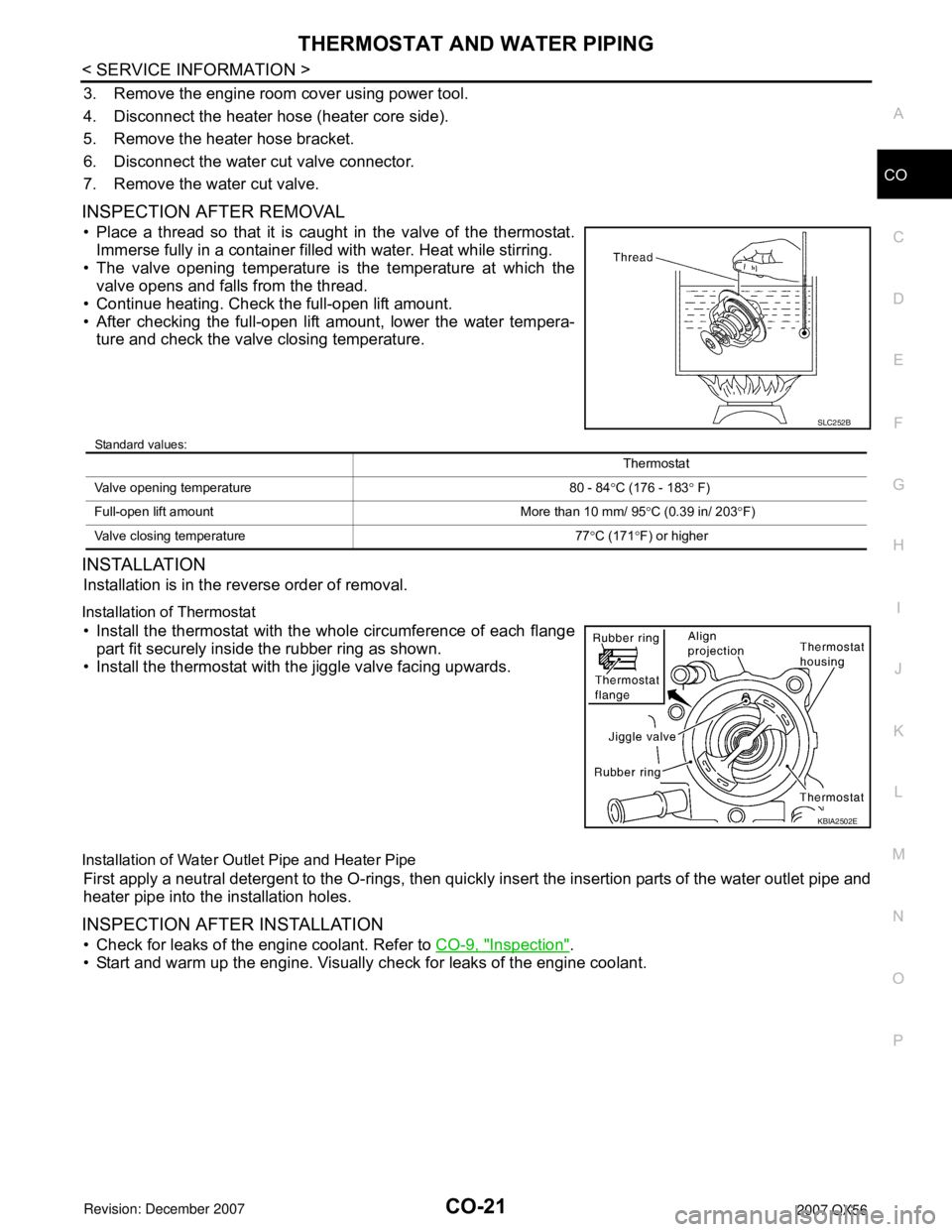
THERMOSTAT AND WATER PIPING
CO-21
< SERVICE INFORMATION >
C
D
E
F
G
H
I
J
K
L
MA
CO
N
P O
3. Remove the engine room cover using power tool.
4. Disconnect the heater hose (heater core side).
5. Remove the heater hose bracket.
6. Disconnect the water cut valve connector.
7. Remove the water cut valve.
INSPECTION AFTER REMOVAL
• Place a thread so that it is caught in the valve of the thermostat.
Immerse fully in a container filled with water. Heat while stirring.
• The valve opening temperature is the temperature at which the
valve opens and falls from the thread.
• Continue heating. Check the full-open lift amount.
• After checking the full-open lift amount, lower the water tempera-
ture and check the valve closing temperature.
Standard values:
INSTALLATION
Installation is in the reverse order of removal.
Installation of Thermostat
• Install the thermostat with the whole circumference of each flange
part fit securely inside the rubber ring as shown.
• Install the thermostat with the jiggle valve facing upwards.
Installation of Water Outlet Pipe and Heater Pipe
First apply a neutral detergent to the O-rings, then quickly insert the insertion parts of the water outlet pipe and
heater pipe into the installation holes.
INSPECTION AFTER INSTALLATION
• Check for leaks of the engine coolant. Refer to CO-9, "Inspection".
• Start and warm up the engine. Visually check for leaks of the engine coolant.
SLC252B
Thermostat
Valve opening temperature 80 - 84°C (176 - 183° F)
Full-open lift amount More than 10 mm/ 95°C (0.39 in/ 203°F)
Valve closing temperature 77°C (171°F) or higher
KBIA2502E
Page 1089 of 3061

EC-6
DTC P0605 ECM ..............................................444
Component Description .........................................444
On Board Diagnosis Logic .....................................444
DTC Confirmation Procedure ................................444
Diagnosis Procedure .............................................445
DTC P0643 SENSOR POWER SUPPLY ........447
On Board Diagnosis Logic .....................................447
DTC Confirmation Procedure ................................447
Wiring Diagram ......................................................448
Diagnosis Procedure .............................................449
DTC P0850 PNP SWITCH ...............................452
Component Description .........................................452
CONSULT-II Reference Value in Data Monitor
Mode ......................................................................
452
On Board Diagnosis Logic .....................................452
DTC Confirmation Procedure ................................452
Overall Function Check .........................................453
Wiring Diagram ......................................................454
Diagnosis Procedure .............................................455
DTC P1140, P1145 IVT CONTROL POSITION
SENSOR ..........................................................
457
Component Description .........................................457
CONSULT-II Reference Value in Data Monitor
Mode ......................................................................
457
On Board Diagnosis Logic .....................................457
DTC Confirmation Procedure ................................457
Wiring Diagram ......................................................458
Diagnosis Procedure .............................................461
Component Inspection ...........................................463
Removal and Installation .......................................464
DTC P1148, P1168 CLOSED LOOP CON-
TROL ................................................................
466
On Board Diagnosis Logic .....................................466
DTC P1211 TCS CONTROL UNIT ..................467
Description .............................................................467
On Board Diagnosis Logic .....................................467
DTC Confirmation Procedure ................................467
Diagnosis Procedure .............................................467
DTC P1212 TCS COMMUNICATION LINE .....468
Description .............................................................468
On Board Diagnosis Logic .....................................468
DTC Confirmation Procedure ................................468
Diagnosis Procedure .............................................468
DTC P1217 ENGINE OVER TEMPERATURE .469
Description .............................................................469
CONSULT-II Reference Value in Data Monitor
Mode ......................................................................
469
On Board Diagnosis Logic .....................................470
Overall Function Check .........................................470
Wiring Diagram ......................................................472
Diagnosis Procedure .............................................473
Main 13 Causes of Overheating ............................476
Component Inspection ...........................................476
DTC P1225 TP SENSOR ..................................477
Component Description ........................................477
On Board Diagnosis Logic ....................................477
DTC Confirmation Procedure ................................477
Diagnosis Procedure .............................................477
Removal and Installation .......................................478
DTC P1226 TP SENSOR ..................................479
Component Description ........................................479
On Board Diagnosis Logic ....................................479
DTC Confirmation Procedure ................................479
Diagnosis Procedure .............................................479
Removal and Installation .......................................480
DTC P1421 COLD START CONTROL ............481
Description ............................................................481
On Board Diagnosis Logic ....................................481
DTC Confirmation Procedure ................................481
Diagnosis Procedure .............................................481
DTC P1550 BATTERY CURRENT SENSOR ...483
Component Description ........................................483
CONSULT-II Reference Value in Data Monitor
Mode .....................................................................
483
On Board Diagnosis Logic ....................................483
DTC Confirmation Procedure ................................483
Wiring Diagram .....................................................485
Diagnosis Procedure .............................................486
Component Inspection ..........................................488
DTC P1551, P1552 BATTERY CURRENT
SENSOR ...........................................................
489
Component Description ........................................489
CONSULT-II Reference Value in Data Monitor
Mode .....................................................................
489
On Board Diagnosis Logic ....................................489
DTC Confirmation Procedure ................................489
Wiring Diagram .....................................................491
Diagnosis Procedure .............................................492
Component Inspection ..........................................494
DTC P1553 BATTERY CURRENT SENSOR ...495
Component Description ........................................495
CONSULT-II Reference Value in Data Monitor
Mode .....................................................................
495
On Board Diagnosis Logic ....................................495
DTC Confirmation Procedure ................................495
Wiring Diagram .....................................................497
Diagnosis Procedure .............................................498
Component Inspection ..........................................500
DTC P1554 BATTERY CURRENT SENSOR ...501
Component Description ........................................501
CONSULT-II Reference Value in Data Monitor
Mode .....................................................................
501
On Board Diagnosis Logic ....................................501
Overall Function Check .........................................501
Wiring Diagram .....................................................503
Diagnosis Procedure .............................................504
Component Inspection ..........................................506
Page 1396 of 3061
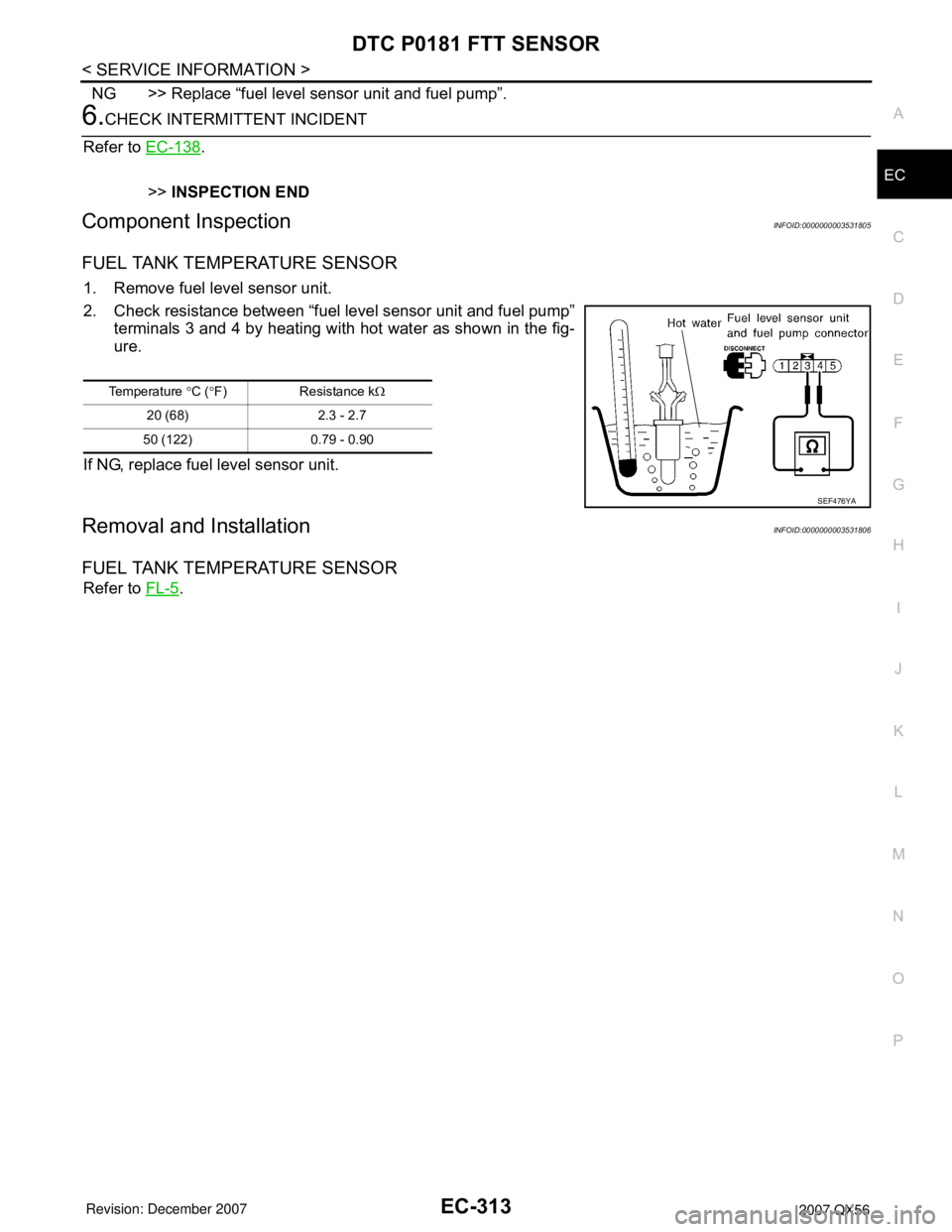
DTC P0181 FTT SENSOR
EC-313
< SERVICE INFORMATION >
C
D
E
F
G
H
I
J
K
L
MA
EC
N
P O
NG >> Replace “fuel level sensor unit and fuel pump”.
6.CHECK INTERMITTENT INCIDENT
Refer to EC-138
.
>>INSPECTION END
Component InspectionINFOID:0000000003531805
FUEL TANK TEMPERATURE SENSOR
1. Remove fuel level sensor unit.
2. Check resistance between “fuel level sensor unit and fuel pump”
terminals 3 and 4 by heating with hot water as shown in the fig-
ure.
If NG, replace fuel level sensor unit.
Removal and InstallationINFOID:0000000003531806
FUEL TANK TEMPERATURE SENSOR
Refer to FL-5.
Temperature °C (°F) Resistance kΩ
20 (68) 2.3 - 2.7
50 (122) 0.79 - 0.90
SEF476YA
Page 1400 of 3061
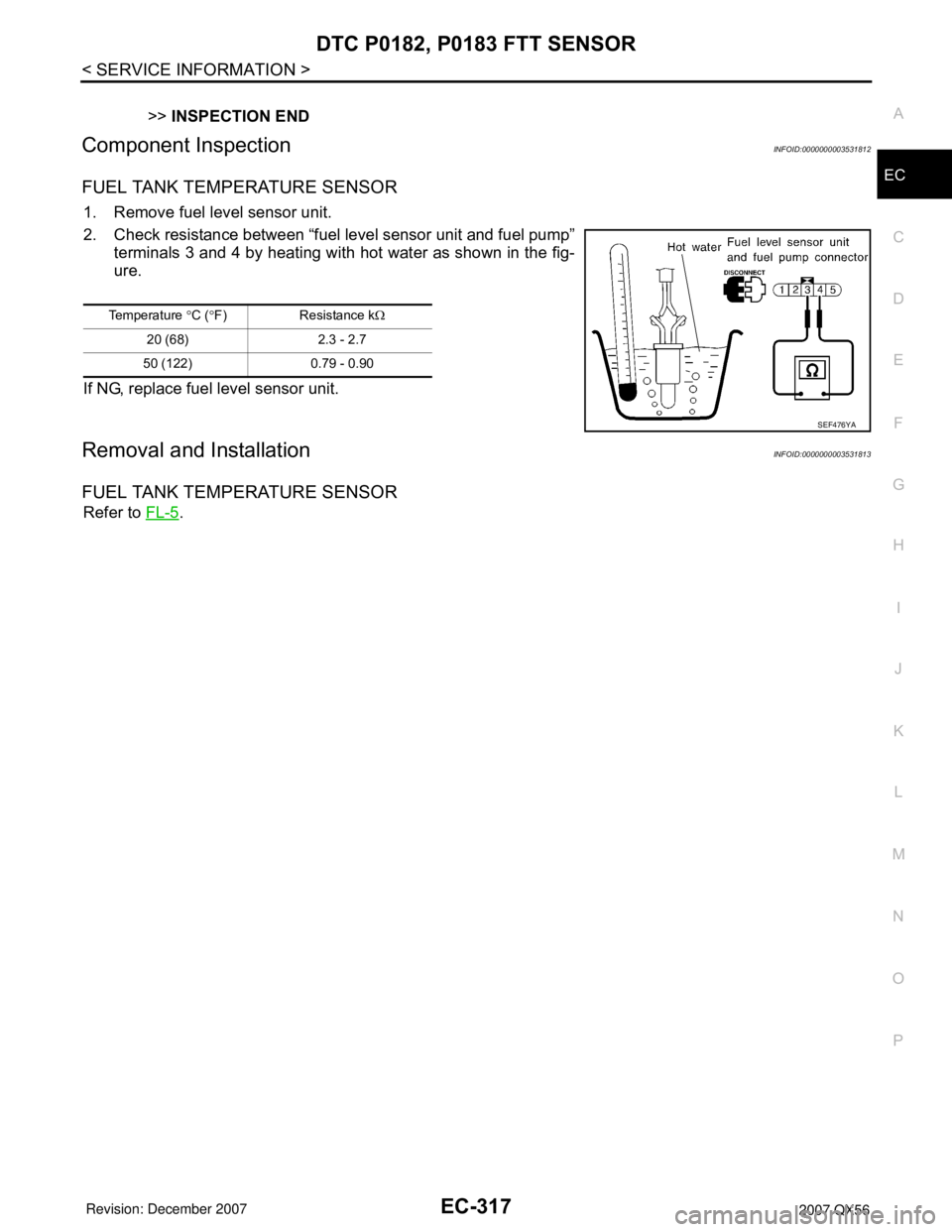
DTC P0182, P0183 FTT SENSOR
EC-317
< SERVICE INFORMATION >
C
D
E
F
G
H
I
J
K
L
MA
EC
N
P O
>>INSPECTION END
Component InspectionINFOID:0000000003531812
FUEL TANK TEMPERATURE SENSOR
1. Remove fuel level sensor unit.
2. Check resistance between “fuel level sensor unit and fuel pump”
terminals 3 and 4 by heating with hot water as shown in the fig-
ure.
If NG, replace fuel level sensor unit.
Removal and InstallationINFOID:0000000003531813
FUEL TANK TEMPERATURE SENSOR
Refer to FL-5.
Temperature °C (°F) Resistance kΩ
20 (68) 2.3 - 2.7
50 (122) 0.79 - 0.90
SEF476YA
Page 1408 of 3061
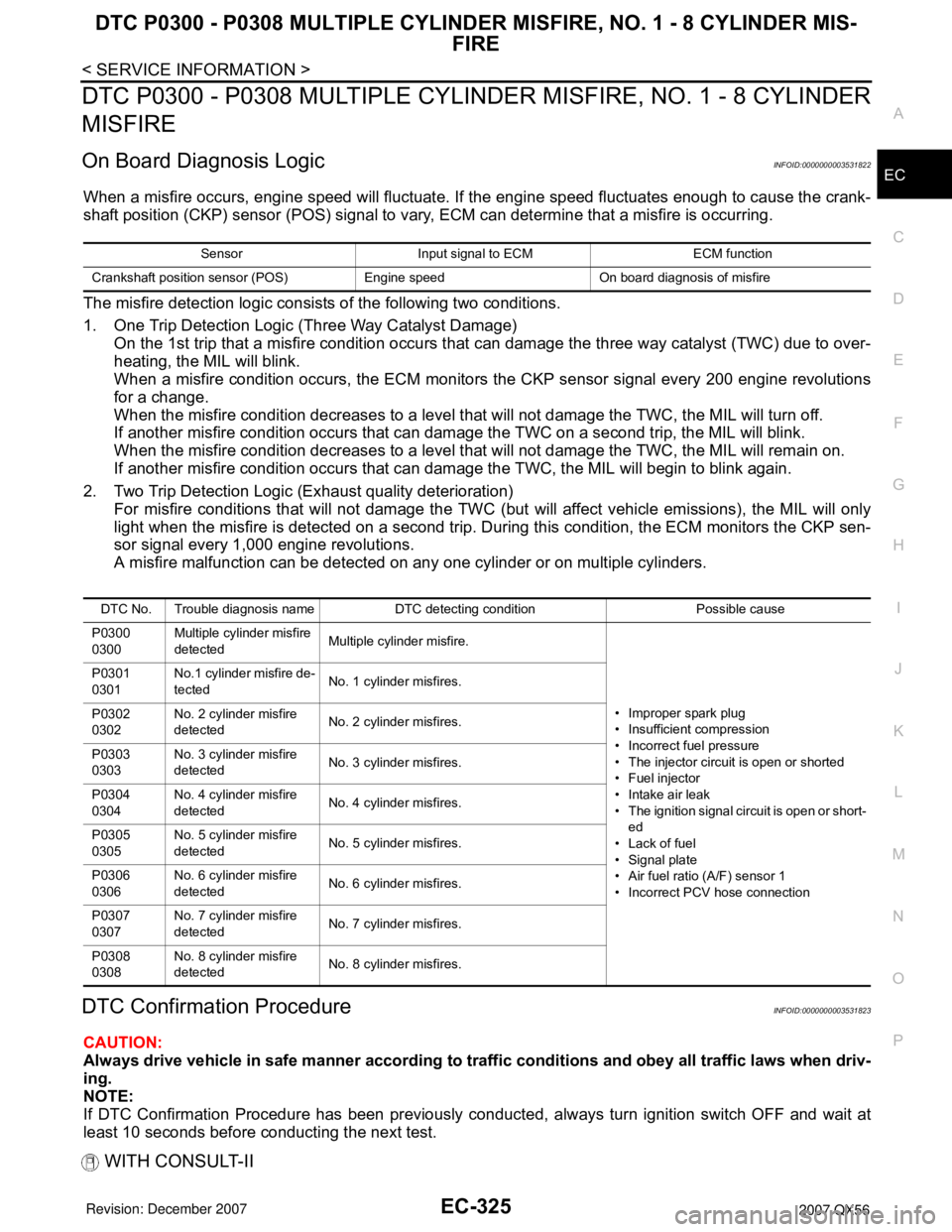
DTC P0300 - P0308 MULTIPLE CYLINDER MISFIRE, NO. 1 - 8 CYLINDER MIS-
FIRE
EC-325
< SERVICE INFORMATION >
C
D
E
F
G
H
I
J
K
L
MA
EC
N
P O
DTC P0300 - P0308 MULTIPLE CYLINDER MISFIRE, NO. 1 - 8 CYLINDER
MISFIRE
On Board Diagnosis LogicINFOID:0000000003531822
When a misfire occurs, engine speed will fluctuate. If the engine speed fluctuates enough to cause the crank-
shaft position (CKP) sensor (POS) signal to vary, ECM can determine that a misfire is occurring.
The misfire detection logic consists of the following two conditions.
1. One Trip Detection Logic (Three Way Catalyst Damage)
On the 1st trip that a misfire condition occurs that can damage the three way catalyst (TWC) due to over-
heating, the MIL will blink.
When a misfire condition occurs, the ECM monitors the CKP sensor signal every 200 engine revolutions
for a change.
When the misfire condition decreases to a level that will not damage the TWC, the MIL will turn off.
If another misfire condition occurs that can damage the TWC on a second trip, the MIL will blink.
When the misfire condition decreases to a level that will not damage the TWC, the MIL will remain on.
If another misfire condition occurs that can damage the TWC, the MIL will begin to blink again.
2. Two Trip Detection Logic (Exhaust quality deterioration)
For misfire conditions that will not damage the TWC (but will affect vehicle emissions), the MIL will only
light when the misfire is detected on a second trip. During this condition, the ECM monitors the CKP sen-
sor signal every 1,000 engine revolutions.
A misfire malfunction can be detected on any one cylinder or on multiple cylinders.
DTC Confirmation ProcedureINFOID:0000000003531823
CAUTION:
Always drive vehicle in safe manner according to traffic conditions and obey all traffic laws when driv-
ing.
NOTE:
If DTC Confirmation Procedure has been previously conducted, always turn ignition switch OFF and wait at
least 10 seconds before conducting the next test.
WITH CONSULT-II
Sensor Input signal to ECM ECM function
Crankshaft position sensor (POS) Engine speed On board diagnosis of misfire
DTC No. Trouble diagnosis name DTC detecting condition Possible cause
P0300
0300Multiple cylinder misfire
detectedMultiple cylinder misfire.
• Improper spark plug
• Insufficient compression
• Incorrect fuel pressure
• The injector circuit is open or shorted
• Fuel injector
• Intake air leak
• The ignition signal circuit is open or short-
ed
• Lack of fuel
• Signal plate
• Air fuel ratio (A/F) sensor 1
• Incorrect PCV hose connection P0301
0301No.1 cylinder misfire de-
tectedNo. 1 cylinder misfires.
P0302
0302No. 2 cylinder misfire
detectedNo. 2 cylinder misfires.
P0303
0303No. 3 cylinder misfire
detectedNo. 3 cylinder misfires.
P0304
0304No. 4 cylinder misfire
detectedNo. 4 cylinder misfires.
P0305
0305No. 5 cylinder misfire
detectedNo. 5 cylinder misfires.
P0306
0306No. 6 cylinder misfire
detectedNo. 6 cylinder misfires.
P0307
0307No. 7 cylinder misfire
detectedNo. 7 cylinder misfires.
P0308
0308No. 8 cylinder misfire
detectedNo. 8 cylinder misfires.
Page 1553 of 3061
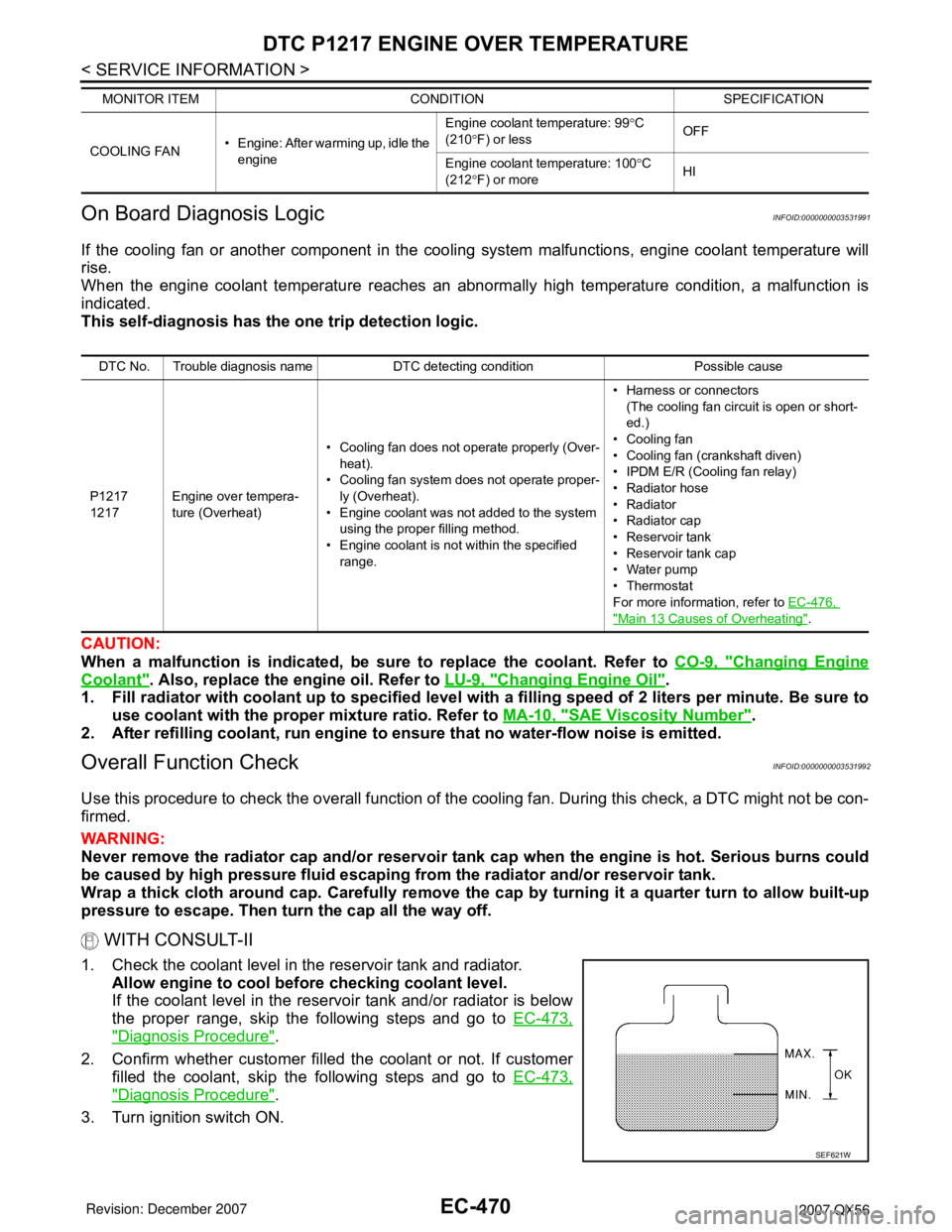
EC-470
< SERVICE INFORMATION >
DTC P1217 ENGINE OVER TEMPERATURE
On Board Diagnosis Logic
INFOID:0000000003531991
If the cooling fan or another component in the cooling system malfunctions, engine coolant temperature will
rise.
When the engine coolant temperature reaches an abnormally high temperature condition, a malfunction is
indicated.
This self-diagnosis has the one trip detection logic.
CAUTION:
When a malfunction is indicated, be sure to replace the coolant. Refer to CO-9, "
Changing Engine
Coolant". Also, replace the engine oil. Refer to LU-9, "Changing Engine Oil".
1. Fill radiator with coolant up to specified level with a filling speed of 2 liters per minute. Be sure to
use coolant with the proper mixture ratio. Refer to MA-10, "
SAE Viscosity Number".
2. After refilling coolant, run engine to ensure that no water-flow noise is emitted.
Overall Function CheckINFOID:0000000003531992
Use this procedure to check the overall function of the cooling fan. During this check, a DTC might not be con-
firmed.
WARNING:
Never remove the radiator cap and/or reservoir tank cap when the engine is hot. Serious burns could
be caused by high pressure fluid escaping from the radiator and/or reservoir tank.
Wrap a thick cloth around cap. Carefully remove the cap by turning it a quarter turn to allow built-up
pressure to escape. Then turn the cap all the way off.
WITH CONSULT-II
1. Check the coolant level in the reservoir tank and radiator.
Allow engine to cool before checking coolant level.
If the coolant level in the reservoir tank and/or radiator is below
the proper range, skip the following steps and go to EC-473,
"Diagnosis Procedure".
2. Confirm whether customer filled the coolant or not. If customer
filled the coolant, skip the following steps and go to EC-473,
"Diagnosis Procedure".
3. Turn ignition switch ON.
COOLING FAN• Engine: After warming up, idle the
engineEngine coolant temperature: 99°C
(210°F) or lessOFF
Engine coolant temperature: 100°C
(212°F) or moreHI MONITOR ITEM CONDITION SPECIFICATION
DTC No. Trouble diagnosis name DTC detecting condition Possible cause
P1217
1217Engine over tempera-
ture (Overheat)• Cooling fan does not operate properly (Over-
heat).
• Cooling fan system does not operate proper-
ly (Overheat).
• Engine coolant was not added to the system
using the proper filling method.
• Engine coolant is not within the specified
range.• Harness or connectors
(The cooling fan circuit is open or short-
ed.)
• Cooling fan
• Cooling fan (crankshaft diven)
• IPDM E/R (Cooling fan relay)
•Radiator hose
•Radiator
•Radiator cap
• Reservoir tank
• Reservoir tank cap
• Water pump
•Thermostat
For more information, refer to EC-476,
"Main 13 Causes of Overheating".
SEF621W
Page 1557 of 3061
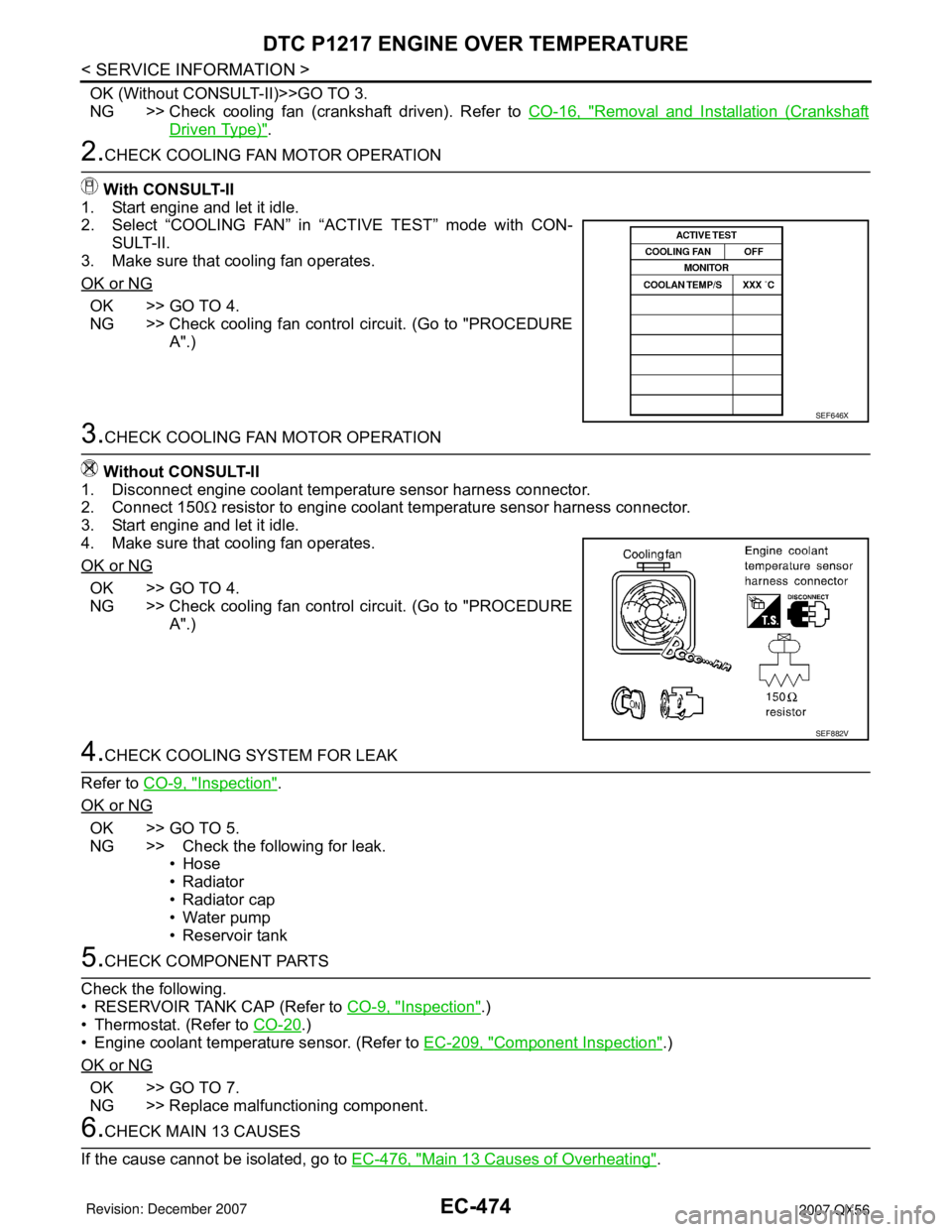
EC-474
< SERVICE INFORMATION >
DTC P1217 ENGINE OVER TEMPERATURE
OK (Without CONSULT-II)>>GO TO 3.
NG >> Check cooling fan (crankshaft driven). Refer to CO-16, "
Removal and Installation (Crankshaft
Driven Type)".
2.CHECK COOLING FAN MOTOR OPERATION
With CONSULT-II
1. Start engine and let it idle.
2. Select “COOLING FAN” in “ACTIVE TEST” mode with CON-
SULT-II.
3. Make sure that cooling fan operates.
OK or NG
OK >> GO TO 4.
NG >> Check cooling fan control circuit. (Go to "PROCEDURE
A".)
3.CHECK COOLING FAN MOTOR OPERATION
Without CONSULT-II
1. Disconnect engine coolant temperature sensor harness connector.
2. Connect 150Ω resistor to engine coolant temperature sensor harness connector.
3. Start engine and let it idle.
4. Make sure that cooling fan operates.
OK or NG
OK >> GO TO 4.
NG >> Check cooling fan control circuit. (Go to "PROCEDURE
A".)
4.CHECK COOLING SYSTEM FOR LEAK
Refer to CO-9, "
Inspection".
OK or NG
OK >> GO TO 5.
NG >> Check the following for leak.
•Hose
• Radiator
• Radiator cap
• Water pump
• Reservoir tank
5.CHECK COMPONENT PARTS
Check the following.
• RESERVOIR TANK CAP (Refer to CO-9, "
Inspection".)
• Thermostat. (Refer to CO-20
.)
• Engine coolant temperature sensor. (Refer to EC-209, "
Component Inspection".)
OK or NG
OK >> GO TO 7.
NG >> Replace malfunctioning component.
6.CHECK MAIN 13 CAUSES
If the cause cannot be isolated, go to EC-476, "
Main 13 Causes of Overheating".
SEF646X
SEF882V